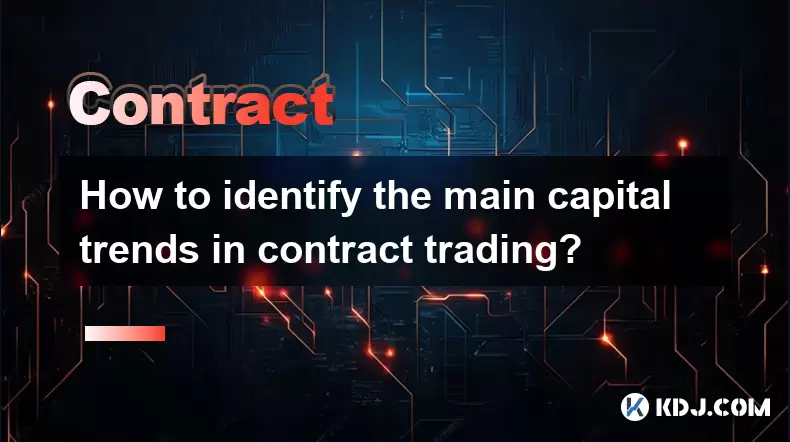-
 bitcoin
bitcoin $87959.907984 USD
1.34% -
 ethereum
ethereum $2920.497338 USD
3.04% -
 tether
tether $0.999775 USD
0.00% -
 xrp
xrp $2.237324 USD
8.12% -
 bnb
bnb $860.243768 USD
0.90% -
 solana
solana $138.089498 USD
5.43% -
 usd-coin
usd-coin $0.999807 USD
0.01% -
 tron
tron $0.272801 USD
-1.53% -
 dogecoin
dogecoin $0.150904 USD
2.96% -
 cardano
cardano $0.421635 USD
1.97% -
 hyperliquid
hyperliquid $32.152445 USD
2.23% -
 bitcoin-cash
bitcoin-cash $533.301069 USD
-1.94% -
 chainlink
chainlink $12.953417 USD
2.68% -
 unus-sed-leo
unus-sed-leo $9.535951 USD
0.73% -
 zcash
zcash $521.483386 USD
-2.87%
How to identify the main capital trends in contract trading?
Monitoring main capital trends through volume, open interest, and on-chain data helps traders anticipate market moves and manage risk effectively.
Jun 18, 2025 at 08:00 pm

What is Contract Trading?
Contract trading, also known as futures trading, involves speculating on the future price of an asset without owning it. It's widely used in cryptocurrency markets, where traders can go long or short based on their expectations of price movement. In this environment, identifying main capital trends becomes essential for making informed decisions and managing risks effectively.
Understanding Main Capital Trends
The term 'main capital trends' refers to the direction and momentum of large institutional or whale investors' movements in the market. These players typically have the resources to influence price action significantly. Their activities often precede major market moves, so recognizing these patterns early can give retail traders a competitive edge.
Key indicators of main capital involvement include sudden spikes in volume, unusual order book imbalances, and abnormal price breakouts that aren't immediately corrected by the market.
Analyzing Volume and Open Interest
One of the most reliable ways to detect main capital trends is through volume and open interest analysis. High trading volume combined with increasing open interest suggests strong participation from large players. Conversely, declining open interest despite high volume might indicate profit-taking or trend exhaustion.
- Look for consistent increases in 24-hour trading volume across major exchanges.
- Monitor changes in open interest on perpetual futures contracts.
- Compare volume spikes with price movements to confirm whether they align with real buying or selling pressure.
This data can be found on platforms like Bybit, Binance Futures, or CoinGlass, which offer detailed analytics on derivatives markets.
Order Book Depth and Liquidity Pools
Examining the order book depth provides insight into how much liquidity exists at various price levels. Large orders placed by institutional players often appear as thick walls of buy or sell orders. These walls can act as psychological support or resistance zones.
- Use tools like Glassnode Studio or Deribit’s order book analyzer to visualize hidden liquidity.
- Watch for sudden disappearance of large order blocks, which may signal absorption by whales.
- Pay attention to bid-ask spreads during low volatility periods — tight spreads suggest active market-making behavior.
Liquidity pools on decentralized exchanges (DEXs) can also reflect shifts in capital allocation, especially when there are significant inflows or outflows from major token pairs.
Funding Rates and Market Sentiment
In perpetual futures contracts, funding rates play a crucial role in signaling market sentiment. Positive funding rates imply more long positions, suggesting bullish expectations, while negative rates point toward bearish dominance.
- Track funding rate changes over time to spot potential reversals.
- Cross-reference funding rate trends with price movements for confirmation.
- Be cautious when funding rates spike abnormally, as it could signal overleveraged positions about to be liquidated.
Sentiment analysis tools such as Crypto Fear & Greed Index or on-chain social metrics can complement this data by offering insights into broader trader psychology.
On-Chain Metrics and Whale Tracking
On-chain activity often reveals the footprints of large holders (whales) moving substantial amounts of crypto. Monitoring blockchain transactions helps identify accumulation or distribution phases initiated by big players.
- Use platforms like Whale Alert or Santiment to track large transfers between wallets and exchanges.
- Observe movement from cold storage to exchange hot wallets — a sign of potential selling pressure.
- Analyze chain link metrics such as netflow to exchanges, realized cap, and entity-adjusted supply dormancy.
These signals, when combined with traditional technical indicators, provide a robust framework for understanding main capital intentions.
Frequently Asked Questions
How do I differentiate between retail and institutional activity in contract trading?
Retail activity tends to be scattered and reactive, often driven by news or social media hype. Institutional trades are usually larger, executed in phases, and accompanied by strategic placement of orders to avoid slippage. Tools like on-chain analytics and order book visualization help distinguish between the two.
Can I use candlestick patterns to identify main capital trends?
Candlestick patterns alone are not sufficient for detecting institutional trends. However, when combined with volume analysis and order book depth, they can offer context. For example, a bullish engulfing pattern supported by rising volume and increased open interest may indicate genuine buying pressure from large players.
Are there specific indicators for tracking main capital in crypto derivatives?
Yes, several specialized indicators exist, including Volume Weighted Average Price (VWAP), Commitment of Traders (CoT) reports (adapted for crypto), and Liquidation Heatmaps. These tools focus on positioning and flow data rather than just price action.
Is it possible to automate detection of main capital trends?
Automation is feasible using APIs from platforms like Binance, Bybit, or CryptoCompare, which allow integration with custom dashboards or trading bots. However, accurate interpretation still requires human oversight due to the complexity and noise in derivative markets.
Disclaimer:info@kdj.com
The information provided is not trading advice. kdj.com does not assume any responsibility for any investments made based on the information provided in this article. Cryptocurrencies are highly volatile and it is highly recommended that you invest with caution after thorough research!
If you believe that the content used on this website infringes your copyright, please contact us immediately (info@kdj.com) and we will delete it promptly.
- Fiji's Currency Gets a Fresh Look: New Polymer Designs and Enhanced Circulation
- 2025-12-21 06:55:01
- Cathie Wood's Ark Invest Adjusts Tesla Investment, Eyes Crypto Opportunities
- 2025-12-21 06:45:02
- Navigating the New Frontier: Crypto Tax Bill, Stablecoins, and De Minimis Rules Take Center Stage
- 2025-12-21 03:35:01
- COIN's Compass: Coinbase Stock Market Performance Charting New Territories Amidst Evolving Crypto Landscape
- 2025-12-20 12:45:01
- GeeFi Rockets Towards 100x Returns, While Ripple Makes Strategic Stablecoin Moves
- 2025-12-20 06:15:02
- Big City Crypto Buzz: Cross-Chain Bridges, Multi-Chain Horizons, and Presales Paving the Future
- 2025-12-19 21:45:01
Related knowledge

How Does the Liquidation Engine Work on a Crypto Exchange?
Dec 19,2025 at 05:59am
Core Mechanism of Margin Liquidation1. When a trader opens a leveraged position, the exchange assigns an initial margin requirement and a maintenance ...

Why is Risk-to-Reward Ratio Crucial in Futures Trading?
Dec 08,2025 at 01:20am
Risk-to-Reward Ratio Defined1. The risk-to-reward ratio quantifies the potential loss against the potential gain for a single futures trade. It is cal...

A Step-by-Step Guide on How to Short Bitcoin with Futures.
Dec 07,2025 at 06:39pm
Understanding Bitcoin Futures Contracts1. Bitcoin futures are standardized agreements to buy or sell BTC at a predetermined price and date in the futu...

Understanding the Relationship Between Leverage and Margin.
Dec 14,2025 at 02:39am
Core Mechanics of Leverage in Crypto Trading1. Leverage allows traders to control a larger position size than their available capital would normally p...

How to Reduce Trading Fees on Your Futures Account.
Dec 11,2025 at 01:20pm
Understanding Fee Structures in Futures Trading1. Exchanges apply distinct fee models based on order type—maker orders add liquidity and receive rebat...

What is the Difference Between Futures and Options Trading?
Dec 18,2025 at 12:40pm
Futures Trading Mechanics1. A futures contract is a standardized agreement to buy or sell a specific asset at a predetermined price and date in the fu...

How Does the Liquidation Engine Work on a Crypto Exchange?
Dec 19,2025 at 05:59am
Core Mechanism of Margin Liquidation1. When a trader opens a leveraged position, the exchange assigns an initial margin requirement and a maintenance ...

Why is Risk-to-Reward Ratio Crucial in Futures Trading?
Dec 08,2025 at 01:20am
Risk-to-Reward Ratio Defined1. The risk-to-reward ratio quantifies the potential loss against the potential gain for a single futures trade. It is cal...

A Step-by-Step Guide on How to Short Bitcoin with Futures.
Dec 07,2025 at 06:39pm
Understanding Bitcoin Futures Contracts1. Bitcoin futures are standardized agreements to buy or sell BTC at a predetermined price and date in the futu...

Understanding the Relationship Between Leverage and Margin.
Dec 14,2025 at 02:39am
Core Mechanics of Leverage in Crypto Trading1. Leverage allows traders to control a larger position size than their available capital would normally p...

How to Reduce Trading Fees on Your Futures Account.
Dec 11,2025 at 01:20pm
Understanding Fee Structures in Futures Trading1. Exchanges apply distinct fee models based on order type—maker orders add liquidity and receive rebat...

What is the Difference Between Futures and Options Trading?
Dec 18,2025 at 12:40pm
Futures Trading Mechanics1. A futures contract is a standardized agreement to buy or sell a specific asset at a predetermined price and date in the fu...
See all articles









































































